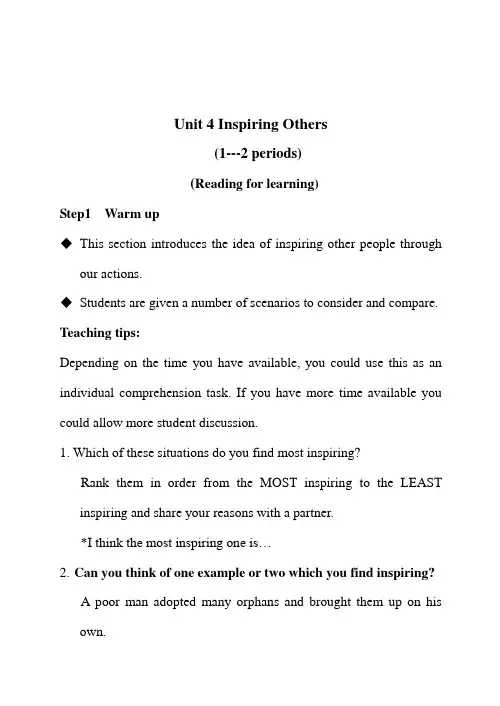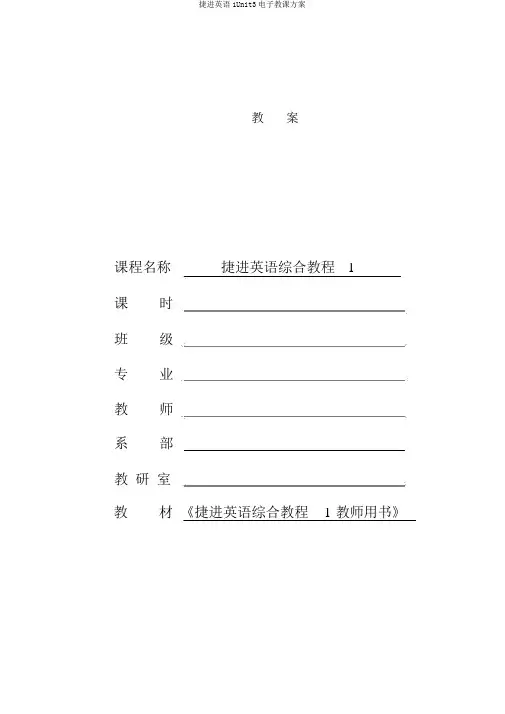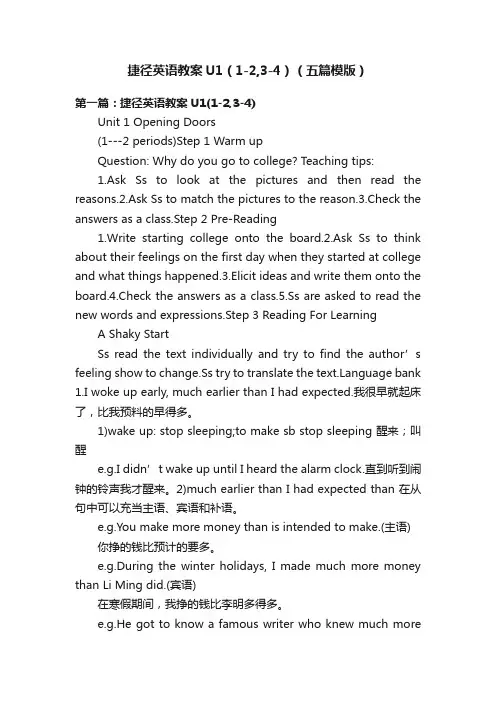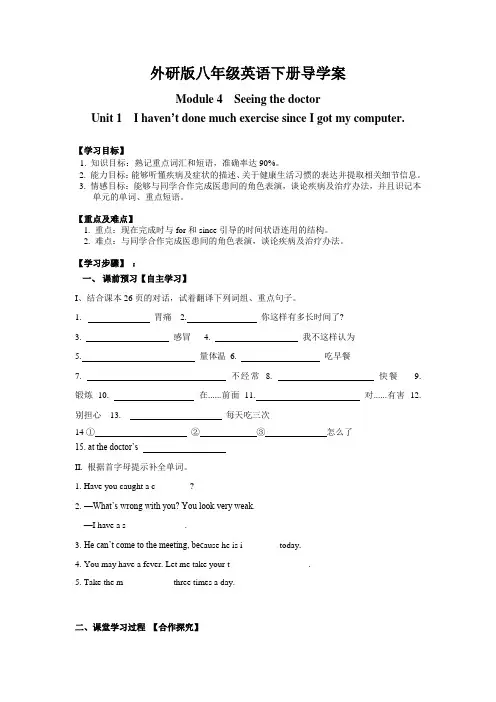捷径英语教学导案U1(1-2-3-4)
- 格式:doc
- 大小:121.00 KB
- 文档页数:7

Unit 4 Inspiring Others(1---2 periods)(Reading for learning)Step1 Warm up◆This section introduces the idea of inspiring other people throughour actions.◆Students are given a number of scenarios to consider and compare. Teaching tips:Depending on the time you have available, you could use this as an individual comprehension task. If you have more time available you could allow more student discussion.1. Which of these situations do you find most inspiring?Rank them in order from the MOST inspiring to the LEAST inspiring and share your reasons with a partner.*I think the most inspiring one is…2.Can you think of one example or two which you find inspiring?A poor man adopted many orphans and brought them up on hisown.Step 2 Words and phrasesTeaching tips:1. Ask Ss to look at the words and explain the meanings to Ss.2. Play the audio again and tell Ss to repeat each word as they hear it. Step 3 Reading for learningThis section starts with recognising time order. It then encourages students to think one approach to text organisation.1. V ocabulary and GrammarStudents look at word formation based on words from the text. They also practise using words related to the theme.The grammar focus revises the use of articles, focusing on the use of the articles—a/an and the.2. Beyond the TextStudents react to quotes and stories.Teaching tips:1. Ask Ss to cover the text, look at the book and listen carefully.2. Ask Ss to uncover the text. Play the tape again and tell Ss tofollow in their books.3. Check Ss’ answers to the question above.3.1 Ask Ss to read the text again. 3.2 Ask Ss to read questions.3.3 Give Ss time to work out the answers.3.4 Check answers.Step 4 Reading and UnderstandingIn Reading and Understanding, Task 1 of identifying the time order also checks students understanding of the main points. Task 2 and Task 3 encourage students to summarise main ideas and to see connections between ideas within the text.Teaching tips:1. Ss should have a quick view without checking detailedunderstanding.2. Recognizing the time order (理解时间顺序)3. Ask Ss to find the answers in the texts.4. Check the answers as a class.Step 5 Vocabulary FocusStep 6 Do the related tasksUnit 4 Inspiring Others(3---4 periods)(Reading for doing )Step 1 RevisionTeaching tips:1. Review what they have learnt in the last class by asking some questions and summarizing the key points and the difficult points.2. Check the homework assigned last time.3. Asking any questions from the students.Step 2 Warm up Teaching tips:Ask Ss to Look at the pictures. Tell a partner what you think are happening in these pictures.1.Ask Ss to discuss the questions in the task in pairs.2.Ask Ss to speak out in pairs.Step 3 Reading for doingFLASH MOBS: Political Statement or Just Fun?1. Students read an article describing flash mobs.2. Students create their own flash mob.3.1 Teaching tips:1. Ask Ss to read the responses and underline keywords.2. Ask Ss to match each response to a problem in the text.3. Check the answers.Step 4 Words and phrases1. statement n.声明;述e.g. We attached no significance to her statement.2. plastic adj. 塑料的e.g. The plastic coating is easy to apply on any surface.3. flash mob快闪运动;快闪族e.g. Some young people organised a flash mob in front of the building today.Step 5 Exercises1. Do the related tasks to the passage.2. Show your response to a partner and discuss the questions.3.Select Ss to present their work.4.Check the answers.Unit 4 Inspiring Others(7---8 periods) (Audio/Video Lab)Step 1 RevisionTeaching tips:1. Review what they have learnt in the last class by asking some questions and summarizing the key points and the difficult points.2. Check the homework assigned last time.3. Asking any questions from the students.Step 2 Warm upTeaching tips:1. Students watch a video showing images of inspiring people and events:(1) listening for main ideas(2) students discuss who and what inspires them2. For each part of the video you might want to play it twice.Students might need more support with Task 4. With weaker classes, provide some phrases or sentences on the board to help them.3. Ask Ss to read the heading and look at the pictures.4. Ask Ss the question given and elicit answers.Step3 Audio/Video labTeaching tips:Listening for the main ideas in a speech1. Look at the pictures. What is happening in each one?Possible answers:In Picture B, it might inspire people to teach others and show them what they know.In Picture C, the person is caring for an elderly person. It might inspire people to look after their elders.2. Watch the video and complete the main ideas.3. Watch the video and complete the main ideas.4. Watch the video and tick the person who inspires others by doing the right thing.5. Watch the video again. Tick the person who inspires others by doing the right thing.Possible answersI agree with some of the advice, especially the first half.Possibly, I know I did when I was a team captain.I find my parents inspiring. They had very little and now they are quite successful.6. Listen to three speakers talking about the things they find inspiring and then match each thing to the speaker.Step 4 SpeakingTeaching tips:Ask Ss to work in groups of four and practice posting letters and parcels with the given information and the following useful expressions:。

四年级上英语教案M4 U1 Do you want some rice外研社(三起)教学内容本节课为四年级上学期英语课程,使用外研社(三起)教材,教学内容为Module 4 Unit 1 "Do you want some rice?"。
本课主要围绕食物和饮料的词汇,以及如何询问和表达对食物的喜好。
通过本课的学习,学生将能够掌握基本的食物和饮料词汇,并能够运用所学句型进行简单的问答。
教学目标1. 知识与技能:学生能够听懂、会说、会读本课的食物和饮料词汇,并能运用句型"Do you want some?"询问他人是否想要某物。
2. 过程与方法:通过小组合作、角色扮演等互动活动,提高学生的英语口语表达能力和合作能力。
3. 情感态度与价值观:培养学生对英语学习的兴趣,增强学生跨文化交流的意识。
教学难点1. 食物和饮料词汇的正确发音和记忆。
2. 句型"Do you want some?"的运用,特别是在实际对话中的灵活运用。
教具学具准备1. 教材:外研社(三起)四年级上册英语教材。
2. 多媒体设备:用于播放PPT和音频材料。
3. 食物和饮料图片卡片:用于视觉辅助教学。
4. 小组活动道具:用于角色扮演和小组讨论。
教学过程1. 课堂导入:通过播放与本课内容相关的英语歌曲,激发学生的学习兴趣,同时复习相关词汇。
2. 新知呈现:利用PPT展示本课的食物和饮料图片,教授新词汇,并通过实物展示强化记忆。
3. 句型练习:通过教师示范、学生模仿、小组练习等方式,让学生熟练掌握句型"Do you want some?"。
4. 角色扮演:学生分组进行角色扮演,模拟餐厅点餐场景,运用所学句型和词汇进行交流。
5. 巩固提高:通过课堂游戏、小组竞赛等形式,巩固所学知识,提高学生的英语运用能力。
板书设计1. 课程Module 4 Unit 1 "Do you want some rice?"2. 新词汇:展示食物和饮料的图片和英文单词。

教案课程名称捷进英语综合教程1课时班级专业教师系部教研室教材《捷进英语综合教程 1 教师用书》Teaching Plan 教学单元单元主题教学内容Unit 3 Time TogetherDifficult partners along the journeyDifficult flatmatesLiving with othersReading for learningDriving Me MadReading for DoingPeople Are StrangeGuided WritingAn InvitationAudio/Video Lab课时8安排讲课环节主要特点讲课活动安排建议This section Depending on the time you haveWarm-up introduces the available,you could also ask students (热身)idea of to write their own sentencesteamwork and describing how they feel about workingworking withReading for learningother people.with others.It encouragesstudents tostart thinkingabout some ofthe advantageanddisadvantagesof teamwork.This section In Reading and Understanding ,you starts with could spend more time on Task1of recognising the identifying the main idea by first main idea. It allowing students to only read the then encourages topic sentence in each case before students to then checking their ideas by readingwrite a brief the whole text.Task2checks the summary of the students detailed understanding and main idea.Task 3 encourages summarising of theVocabulary andmain ideas.Grammar In Vocabulary Focus , Task 1 builds on Students look atthe theme of teamwork.Task 2 combines some challengingteamwork and travel and acts as good words and phrasespreparation for the Beyond the Text from the text. Tasktask. If you have time, you could2 gets them to usediscuss the students’ opinion of theReading(阅读)Readingfordoing the words in a realworld context andTask 3 tests theirability tounderstand somecommon collocates.The grammar sectionworks on the pastperfect, a usefultext for narratingevents.Beyond the TextStudents look at arange of adventuretrips.Students read areflectivearticle on aperson ’sexperiences ofliving withother people.An invitation:(1) rejectingtrip.The Grammar Focus part looks at thepast perfect. After focusing on theform students then practise using thestructure in the context of travel andteamwork.Beyond the Text students look at arange of trips they could make thatreflect, in a simple way, thechallenges of the reading text.If you have more time, you couldhighlight some of the structures usedfor giving advice. Students mightfindthis useful when they move onto thevideo section.Before students read the letters youcould brainstorm a range of contextsGuided Writing Audio/Video LabWrap-up invitations for inviting people out.(2) signing off When checking Task 2 highlight theformal / cautious nature of rejecting.With weaker students you might want toshow them the model first before theywrite their invitation.Students watch a Write flatmate onto the board and ask video showing students to discuss their experiencesome of the of living with others.difficulties ofFor each part of the video you might living withwant to play it twice.others:Students might need more support with (1) listening forTask 5 and Task 6. With weaker classes, feelingsprovide some phrases or sentences on (2) listening for the board to help them.apologiesThis section Task 1 should be set as pair work. Task provides a quick 2 and Task 3 could be set as homeworkreview of the or as a competitive game.vocabulary,Task 4 and Task 5 should be set as small grammar,group discussion tasks.writing andtheme of theunit.作业课后总结与反思Tasks could beset forindividual workor done inpairs.课后学习设计Finish all the exercises in Unit 3.Read the two texts in this unit again and try to summarise their contents.Make a plan for your travel in the near future.。

捷径英语教案U1(1-2,3-4)(五篇模版)第一篇:捷径英语教案U1(1-2,3-4)Unit 1 Opening Doors(1---2 periods)Step 1 Warm upQuestion: Why do you go to college? Teaching tips:1.Ask Ss to look at the pictures and then read the reasons.2.Ask Ss to match the pictures to the reason.3.Check the answers as a class.Step 2 Pre-Reading1.Write starting college onto the board.2.Ask Ss to think about their feelings on the first day when they started at college and what things happened.3.Elicit ideas and write them onto the board.4.Check the answers as a class.5.Ss are asked to read the new words and expressions.Step 3 Reading For LearningA Shaky StartSs read the text individually and try to find the author’s feeling show to change.Ss try to translate the nguage bank 1.I woke up early, much earlier than I had expected.我很早就起床了,比我预料的早得多。
1)wake up: stop sleeping;to make sb stop sleeping 醒来;叫醒e.g.I didn’t wake up until I heard the alarm clock.直到听到闹钟的铃声我才醒来。

外研版八年级英语下册导学案Module 4 Seeing the doctorUnit 1 I haven’t done much exercise since I got my computer.【学习目标】1. 知识目标:熟记重点词汇和短语,准确率达90%。
2. 能力目标:能够听懂疾病及症状的描述、关于健康生活习惯的表达并提取相关细节信息。
3. 情感目标:能够与同学合作完成医患间的角色表演,谈论疾病及治疗办法,并且识记本单元的单词、重点短语。
【重点及难点】1. 重点:现在完成时与for和since引导的时间状语连用的结构。
2. 难点:与同学合作完成医患间的角色表演,谈论疾病及治疗办法。
【学习步骤】:一、课前预习【自主学习】I、结合课本26页的对话,试着翻译下列词组、重点句子。
1.胃痛2. 你这样有多长时间了?3. 感冒4. 我不这样认为5. 量体温6. 吃早餐7. 不经常8. 快餐9. 锻炼10. 在......前面11. 对......有害12. 别担心13. 每天吃三次14 ①②③怎么了15. at the doctor’sII. 根据首字母提示补全单词。
1. Have you caught a c________?2.—What’s wrong with you? You look very weak.—I have a s_____________ .3.He can’t come to the meeting, bec ause he is i________ today.4.You may have a fever. Let me take your t__________________.5. Take the m___________ three times a day.二、课堂学习过程【合作探究】Step1 Match the words in the box with the pictures.cough fever headachestomach ache toothacheStep2 Listen and check (√) what’s wrong with Betty and Daming.Betty Damingcoughfeverheadachestomach achetoothacheStep3. Complete the passage with the words in the box.cough fever health stomachache temperatureIt is easy to look after your (1) _______. Just do some exercise, such as running. Do not eat fast food! It may give you a (2) ___________. Most illnesses are not dangerous but when you catch a cold or get a (3) _______, you may also get a (4) _______. This means your (5) ___________ is higher than usual. You must go to the doctor.Step4. Listen and ch eck (√)what’s wrong with Betty and Daming.(Activity 2)Step5. III. Listen and complete the table about Daming.Illness (1) and .How long (2)For about .Why (3)①food and no .②He spendsin front of the .What to do (4)First, stop eating and.Second, get some .Take some a day.Step6. Listen and notice the intonation1. How can I help you?2. How long have been like this?3. Have you caught a cold?4. Do you do any exercise?分析: 英语有两种基本语调:升调和降调。


Module 1Unit 1 We lived in a small house.教学目标:1、知识目标:(1)新单词life ,different, ago, any, television, grandchildren, us, grandmother, lady (2)新句型:There be ……, We lived…many years ago. We live…now.2、技能目标:能根据情境正确使用There be ……,We lived…many years ago. We live…now.句型谈论生活、学习中的事物,提出问题并作出解答。
3、情感目标:比较过去与现在的生活,体会并珍惜现在的幸福生活。
教学重点:新单词和新句型的教学与运用。
教学难点:学会There be ...,We lived…many years ago. We live…now.句型并能在生活中灵活运用该句型。
教学工具:两幅画有房子和汽车的画(房子一大一小),单词卡片,点读笔,贴纸,课件。
教学过程:Step1 Leading in(热身复习)T:Good morning, boys and girls!Ss:Good morning, Ms Cao.T:Sit down, please.Ss: Thank you!T: Now,let’s enjoy a video. And then tell me what’s the programme about? Attention here about this word programme. Let’s listen and repeat.Boys read.Girls read.Let’s read together.Let’s watch the programme.T: What’s the programme about?S1: China.T: Yes. It’s about China.Step2 Let’s learn.课文引入:T: Please look at this picture. Let’s look and guess.Who are they?Where are they?Can you guess what will they do?Attention here. There is a TV.Let’s watch and answer.文本学习,单词学习,知识点讲解Look here, let’s read together. Attention this word still. Let’s listen and repeat.教师出示单词卡片,学生拍卡片读。

三年级上册Unit 2 My School Things分课时教学设计Period 1 Get ready & Start up.一、学习内容分析本课时学习内容为2单元Get ready和Start up板块。
本课含两个语篇:一首儿歌和一篇简短对话。
儿歌内容主要描述了准备上学时需要携带的物品,包括笔、铅笔、铅笔盒、书包、书和尺子。
对话内容主要描述了Tom询问姐姐Amy书包里都是什么的情境。
(what)。
通过儿歌和对话,孩子们可以轻松地学习基本学具的英文单词,增加词汇量,教育孩子们学会整理和准备上学所需的物品,培养他们的自理能力和责任感。
(why)儿歌和对话均为简单句和重复问答,便于记忆和学习,易于理解和模仿,问题"What's this?"和"What's that?"多次出现,有助于加深记忆。
(how)二、学习者分析已知知识:学生已经掌握了一些学习用品的英语表达,如book,pencil 等,能听懂简单的英语指令。
未知知识:学生对特定的学习用品词汇不熟悉,如pencil case, ruler, eraser等;不熟悉询问物品名称的句型"What's this?"。
语言能力:学生的英语阅读能力还在初级阶段,需要图片辅助和教师的指导帮助理解。
注意力:三年级学生注意力集中时间相对较短,需要通过多样化的教学活动来维持兴趣。
三、课时学习目标学习理解:在看、听、说的活动中,梳理、学习学习用品相关词汇并能简单运用;应用实践:在教师的帮助下,理解课文内容,掌握核心句型并能分角色表演对话;迁移创新:运用所学语言在小组内通过“我画你猜”的方式交流和展示自己关于学习用品的绘画内容。
四、教学难点分析及解决策略难点:学生对学习用品的英文表达不够熟悉,难以快速反应和使用。
解决策略:通过图片和实物结合的方式,加强学生对词汇的视觉记忆。

Unit 1 Opening Doors(1---2 periods)Step 1 Warm upQuestion:Why do you go to college?Teaching tips:1.Ask Ss to look at the pictures and then read the reasons.2.Ask Ss to match the pictures to the reason.3.Check the answers as a class.Step 2 Pre-Reading1.Write starting college onto the board.2. Ask Ss to think about their feelings on the first day when they startedat college and what things happened.3. Elicit ideas and write them onto the board.4. Check the answers as a class.5. Ss are asked to read the new words and expressions.Step 3 Reading For LearningA Shaky StartSs read the text individually and try to find the author’s feeling show to change. Ss try to translate the text.Language bank1. I woke up early, much earlier than I had expected.我很早就起床了,比我预料的早得多。
1) wake up: stop sleeping; to make sb stop sleeping 醒来;叫醒e.g. I didn’t wake up until I heard the alarm clock.直到听到闹钟的铃声我才醒来。


Unit 4 Inspiring Others(1---2 periods)(Reading for learning)Step1 Warm up◆This section introduces the idea of inspiring other peoplethrough our actions.◆Students are given a number of scenarios to considerand compare.Teaching tips:Depending on the time you have available, you could use this as an individual comprehension task. If you have more time available you could allow more student discussion. 1. Which of these situations do you find most inspiring?Rank them in order from the MOST inspiring to the LEAST inspiring and share your reasons with a partner.*I think the most inspiring one is…2.Can you think of one example or two which you find inspiring?A poor man adopted many orphans and brought themup on his own.Step 2 Words and phrasesTeaching tips:1. Ask Ss to look at the words and explain the meanings to Ss.2. Play the audio again and tell Ss to repeat each word as they hear it.Step 3 Reading for learningThis section starts with recognising time order. It then encourages students to think one approach to text organisation.1. Vocabulary and GrammarStudents look at word formation based on words from the text. They also practise using words related to the theme. The grammar focus revises the use of articles, focusing on the use of the articles—a/an and the.2. Beyond the TextStudents react to quotes and stories.Teaching tips:1. Ask Ss to cover the text, look at the book and listen carefully.2. Ask Ss to uncover the text. Play the tape again and tellSs to follow in their books.3. Check Ss’answers to the question above.3.1 Ask Ss to read the text again. 3.2 Ask Ss to read questions.3.3 Give Ss time to work out the answers.3.4 Check answers.Step 4 Reading and UnderstandingIn Reading and Understanding, T ask 1 of identifying the time order also checks students understanding of the main points. Task 2 and T ask 3 encourage students to summarise main ideas and to see connections between ideas within the text.Teaching tips:1. Ss should have a quick view without checking detailedunderstanding.2. Recognizing the time order (理解时间顺序)3. Ask Ss to find the answers in the texts.4. Check the answers as a class.Step 5 Vocabulary FocusStep 6 Do the related tasksUnit 4 Inspiring Others(3---4 periods)(Reading for doing )Step 1 RevisionTeaching tips:1. Review what they have learnt in the last class by asking some questions and summarizing the key points and the difficult points.2. Check the homework assigned last time.3. Asking any questions from the students.Step 2 Warm up Teaching tips:Ask Ss to Look at the pictures. Tell a partner what you think are happening in these pictures.1.Ask Ss to discuss the questions in the task in pairs.2.Ask Ss to speak out in pairs.Step 3 Reading for doingFLASH MOBS: Political Statement or Just Fun?1. Students read an article describing flash mobs.2. Students create their own flash mob.3.1 Teaching tips:1. Ask Ss to read the responses and underline keywords.2. Ask Ss to match each response to a problem in the text.3. Check the answers.Step 4 Words and phrases1. statement n.声明;述e.g. We attached no significance to her statement.2. plastic adj. 塑料的e.g. The plastic coating is easy to apply on any surface.3. flash mob快闪运动;快闪族e.g. Some young people organised a flash mob in front of the building today.Step 5 Exercises1. Do the related tasks to the passage.2. Show your response to a partner and discuss the questions.3.Select Ss to present their work.4.Check the answers.Unit 4 Inspiring Others(7---8 periods) (Audio/Video Lab)Step 1 RevisionTeaching tips:1. Review what they have learnt in the last class by asking some questions and summarizing the key points and the difficult points.2. Check the homework assigned last time.3. Asking any questions from the students.Step 2 Warm upTeaching tips:1. Students watch a video showing images of inspiring people and events:(1) listening for main ideas(2) students discuss who and what inspires them2. For each part of the video you might want to play it twice.Students might need more support with Task 4. With weaker classes, provide some phrases or sentences on the board to help them.3. Ask Ss to read the heading and look at the pictures.4. Ask Ss the question given and elicit answers.Step3 Audio/Video labTeaching tips:Listening for the main ideas in a speech1. Look at the pictures. What is happening in each one? Possible answers:In Picture B, it might inspire people to teach others and show them what they know.In Picture C, the person is caring for an elderly person. It might inspire people to look after their elders.2. Watch the video and complete the main ideas.3. Watch the video and complete the main ideas.4. Watch the video and tick the person who inspiresothers by doing the right thing.5. Watch the video again. Tick the person who inspires others by doing the right thing.Possible answersI agree with some of the advice, especially the first half. Possibly, I know I did when I was a team captain.I find my parents inspiring. They had very little and now they are quite successful.6. Listen to three speakers talking about the things they find inspiring and then match each thing to the speaker. Step 4 SpeakingTeaching tips:Ask Ss to work in groups of four and practice posting letters and parcels with the given information and the following useful expressions:。
Period 2 Speed up.一、学习内容分析本课时学习内容为第4单元Speed up板块。
本课语篇为配图故事,内容主要讲述了鸡妈妈孵小鸡的过程。
鸡妈妈通过鸡蛋的数量,知道自己有十二个鸡宝宝。
鸡妈妈因为孵小鸡比较辛苦,突然感到饥饿,觅食回来发现少了一颗蛋,焦急寻找,却听到了“cheep,cheep”的叫声,原来是所有鸡宝宝都从蛋壳里钻了出来。
(what)通过一个小鸡孵化的故事,以计数和观察为核心,教育儿童基本数学技能,培养观察力和情感认知,同时强调了生命奇迹和自然规律的重要性。
(why)语言简单易懂,适合三年级学生。
故事通过重复的数字和“Cheep!”来增加趣味性和记忆点。
问题结构清晰,通过提问和回答的形式引导孩子们思考和参与。
(how)二、学习者分析已知知识:基本的数字认知1-12;基本的英语单词和简单句型。
未知知识:故事中涉及的转折情节和“Cheep!”代表的含义需要进一步解释。
语言能力:能够理解和使用基本的英语单词和句型,但需要帮助理解和使用更复杂的句子。
注意力:孩子们的注意力可能容易分散,需要通过有趣的活动来吸引他们。
三、课时学习目标1、学习理解:通过观看视频、听音频、跟读模仿等活动,理解故事的内容和意义,以及对话中传递出的数学概念和母亲的关爱。
2、应用实践:学生能够在教师的引导下,将故事表演出来(水平较好的孩子可进行转述或复述);3、迁移创新:学生能够在教师的指导下,尝试改编故事或续写故事,展示语言的创新能力。
四、教学难点分析及解决策略难点:学生可能对某些家庭成员的英文表达不够熟悉,在发音上也存在困难。
解决策略:通过图片、实物、角色扮演等直观教学手段帮助学生记忆词汇;通过跟读、模仿等活动加强发音训练。
Module1.Stories模块教学目标:本模块是有关德育的故事教育课。
在第一单元里,Janet给Jiamin 讲了一个有关龟兔赛跑的故事。
在第二单元里,讲述了一个农民守株待兔的故事。
语法和交际功能:1、能使用一般现在时理解和复述故事。
2、一般过去时的否定句:didn’t want3、以don’t引导的祈使句。
4、一般过去时would引导的重句:The hare was sure he would win.5、使用should的建议:I should be careful and patient.6、will引导的条件重句:If you eat me, he will not be happy.7、一般过去时动词的变化交际功能句子:1、Are you OK?2、You are like….3、What do you mean?4、You know….5、That’right.6、Don’t move.7、I’ll eat you up.8、Go for it.词汇:名词:tortoise, hare, race, meal, work, field, nothing, ground, farmer, snake, bottle, crow, elephant, danger, weather, sure, proud, careless, slow, careful, old, patient, sad, steady.动词:carry, save, crash, appear, pick up.形容词:kind, bad, clever, heavy, small, great,cold, poor, warm, silly, alive, delicious, hard, dark.短语:in such a hurry, from then on, all day long副词:suddenly, fast,语言目标:比较四种时态学习目标:1、能读懂故事并用一般过去时复述故事。
Period 4 Hit it big & Wrap up
一、学习内容分析
本课时学习内容为第三单元Hit it big和我Wrap up板块。
本课时语篇关于颜色识别和描述的活动指导,鼓励学生观察周围、记录环境中的颜色,并进行问答练习。
(what)
通过寻找和指出颜色,锻炼学生的观察力和注意力。
通过绘画和问答,促进学生之间的交流与合作,激发学生的创造性思维。
(why)重复练习核心句型"What colour is it?"和"It's...",有助于学生记忆、理解和模仿,提供了语言实践的机会。
(how)
二、学习者分析
学生可能已经掌握了一些基本颜色词汇,如黄色(yellow)、红色(red)、绿色(green),橙色(orange)、紫色(purple)、粉色(pink)等。
未知知识:学生无法组织语言描述这个身边的事物和这个多姿多彩的世界。
语言能力:三年级学生熟悉颜色相关的问答,但在英语表达的流畅性和准确性上还有待提高。
注意力:学生注意力容易分散,需要通过有趣的活动和视觉刺激来维持兴趣。
三、课时学习目标
学习理解:学生能够通过快问快答、单元笔记等活动回顾本单内容。
应用实践:学生能够画一幅“身边的颜色”图画,并在课堂上介绍。
迁移创新:学生能够用颜色记录自己的一天。
梳理反思:学生能够了解本单元的核心语言和学习目标,理解家人对于个人成长的重要性;
四、教学难点分析及解决策略
难点:学生在创造性地画图时缺乏灵感。
解决策略:提供示例,鼓励学生小组合作和讨论,引导学生观察身
边细节。
新外研版小学四年级上册英语教案Module 1Unit1 Go straight on教学目标:1、让学生掌握turn left \turn right \go straight on。
2、学会用Where's ...? 来问路。
3、在各种活动中培养学生学习英语的兴趣。
教学重点:1、会用Where's ...? 来打听道路。
2、能听懂turn left \turn right \go straight on。
教学难点:left \ rignt \go straight on 的正确发音。
教学准备:小红旗、糖果、若干卡片、自制小地图、多媒体课件、简易地图(学生每两人一张)教学过程:Step1. Warming-upT: Hello! Boys and girls! Nice to see you!Ss: Hello! Miss Gao! Nice to see you ,too!T: I'm happy ! Are you happy?Ss: Yes!T: So let's sing a song , ok?(教学意图:上课前的热身运动,边唱边表演符合小学生的年龄特点,吸引了学生的注意力,稳定了学生的情趣,也活跃了课堂气氛。
)Step2. Presentation1. T: Sam wants to go to Daming's home , but he is lost , let' s have a look .(播放课件)2. T: There are some places in the classroom . Can you show me where's the school \ park \zoo \KFC \ supermarket? (事先把几幅相应的图片贴在教室的各个角落)The Ss point them outT: Is the school on my left ? (学生听不懂,用中文翻译一遍)(教学意图:以情境引入教学,并使用多媒体课件辅助,更易使学生快速进入学习意境,以听指的方法来复习学过的单词,既巩固了旧知,又自然地引出了新知:left / right )3. Teaching the two words : left / right (出示单词卡片)4. Practicing the two new words:A.Guessing where's the sweet .(猜对的学生,把那个糖果给他)B. 踏步练习:left ,right,(分组练习)5. 指定一名学生上来再做一组练习后,发出新指令:Turn left ! (学生没有反应,不明白什么意思,教师用肢体语言表示其意)6.出示卡片:Turn 师带读7. 贴出标志图:1Turn left Turn right8 . Competition.规则:每组选一名同学上台,听教师指令,做左转、右转,做错的同学淘汰下去,最后一名站在台上的同学就是胜利者,可为自己小组加10分。
Unit1 I like dogsTeaching contents 教学内容Checkout time & ticking timeTeaching aims and learning objectives 教学目标1.能熟练听懂、会读、会拼写本单元单词。
2.能熟练听懂、会说、会读、会运用本单元句型。
3.能熟练会说本单元小诗:Little monkey。
4.完成《补充习题》以及《伴你学》部分练习。
Focus of the lesson and predicted area of difficulty 教学重点和难点教学重点1.能熟练听懂、会读、会拼写本单元单词。
2.能熟练听懂、会说、会读、会运用本单元句型。
3.能熟练会说本单元小诗:Little monkey。
4.完成《补充习题》以及《伴你学》部分练习。
教学难点完成《补充习题》以及《伴你学》部分练习。
学生能否在课上完成练习,怎么样对后进生进行补差?Teaching aids教学准备挂图,卡片,多媒体(PPT)Teaching procedures教学过程Step 1 Greeting1.Dictation –animal , cute , panda, elephant, like dogs, a cute lion2.Sing a song: Do you like purple grapes?Show time(1)把自己上一节课回去编的歌曲在班级里唱一唱;Step 2 :Revision1–Students act out the dialogues in roles .(2)Story time(3)Cartoon time2.- Play a game----“Yes or No ” questionsPPT图片展示动物的形象,学生回答问题“Are they on the farm , too ? Do you like them ?”3–Can you spell ?(利用PPT复习关于动物类的单词,并作“Ticking time ”) Show some more pictures about the different animals for the students to talk about and tell them to protect the animals .Step 3;Rhyme time :Show the pictures on the PPT and teach the rhyme . Note the key points on the blackboard .in the tree , on the mate , run with me , cute and fatT: Can you rewrite a new rhyme with “lion /elephant ?”e.g.: Big lionBig lion, eat a chicken.Big tiger, has a brother.Big horse, go to north.Big elephant, very elegantStep 4: Sound time1. Students look at picture on P10 and listen to me .PPT 展示字母“g”的发音以及单词;2.辩音练习:orange,tiger , log , bag , dog , morning , go ,doll 等单词中哪些单词中的“g”发【g】音?3.Repeat after the tape and fill in the blanks with the correct words .4.Task 1—你能找出更多的单词含有“g”并发音【g】的吗?bug , god , goose , pig , glad , dig ,jog,etc.2. 你能用找到的词,组成一个句子吗?e.g.Oh my god , the goose and the pig are jogging .Students complete the “Ticking time” together .Step 5 Checkout time----Ask and answer1.Work in pairsA: What’s this/that?B: It’s a/ an…A: Do you like…?B: Yes, I do. They’re…No, I don’t. I like… They’re…2.Writing time选择一幅图,写一个对话Step 6 Consolidation1.练习与测试--Complete the exercises given on the PPT;2.完成《伴你学》上相关的练习。
捷径英语教案U1(1-2-3-4)————————————————————————————————作者:————————————————————————————————日期:2Unit 1 Opening Doors(1---2 periods)Step 1 Warm upQuestion:Why do you go to college?Teaching tips:1.Ask Ss to look at the pictures and then read the reasons.2.Ask Ss to match the pictures to the reason.3.Check the answers as a class.Step 2 Pre-Reading1.Write starting college onto the board.2. Ask Ss to think about their feelings on the first day when they startedat college and what things happened.3. Elicit ideas and write them onto the board.4. Check the answers as a class.5. Ss are asked to read the new words and expressions.Step 3 Reading For LearningA Shaky StartSs read the text individually and try to find the author’s feeling show to change. Ss try to translate the text.Language bank1. I woke up early, much earlier than I had expected.我很早就起床了,比我预料的早得多。
1) wake up: stop sleeping; to make sb stop sleeping 醒来;叫醒e.g. I didn’t wake up until I heard the alarm clock.直到听到闹钟的铃声我才醒来。
2) much earlier than I had expectedthan 在从句中可以充当主语、宾语和补语。
e.g. You make more money than is intended to make. (主语)你挣的钱比预计的要多。
e.g. During the winter holidays, I made much more money than Li Ming did. (宾语) 在寒假期间,我挣的钱比李明多得多。
e .g. He got to know a famous writer who knew much more knowledge than his own.(表语) = ...much more than his own knowledge was.3他认识了一位比自己更有学识的著名作家。
2.I was excited and frightened as I entered the first class.走进第一节课的教室时,我既兴奋又害怕。
1) frightened: adj. feeling afraid 害怕的;受惊的e.g. Don’t be frightened. We’re not going to hurt you. 别害怕,我们不会伤害你的。
e.g. I was frightened of being left by myself in the house. 我害怕一个人被留在屋里。
e.g. The boy was frightened to speak. 那男孩子不敢说话。
e.g. She’s frightened that her ex-husband will find her. 她害怕前夫会找到她。
2) 不要混淆frightened 和frightening,前者形容主观感觉,后者形容客观事物。
试比较:e.g. a frightened child 一个受了惊吓的男孩e.g. a frightening experience 一次令人害怕的经历3. As I didn’t know anyone in my class and the class wasn’t about to start, I was playing nervously on my mobile phone.在班上我不认识其他同学,而且离上课还早得很,我开始紧张地玩起了手机。
词语辨析:as,because,since 和for 都可以用来表示原因。
1) as 和since如果原因已为听者或读者所知,或者它不是句子里最重要的部分,就用as和since。
as 从句和since 从句常常放在句首。
而且as 从句和since 从句都是比较正式的说法。
e.g. As it was getting late, I turned around to start for home.天色渐渐晚了,我转身准备回家。
2) because 更强调原因,经常用来引出听者或读者所不知道的新信息。
如果原因是句子里最重要的部分,通常将because 从句放在句末,because 从句也可以独自成句,as 从句和since 从句则不能这样用。
e.g. We didn’t enjoy the day because the weather was so awful.那天我们很不尽兴,因为天气实在太糟。
3) for 引出的是新信息,但它暗示所给的原因是后来想到的。
for 从句几乎可以放在括号里,且从不放在句首,也不能单独成句。
for 的这种用法,在正式的书面语中最为常见。
e.g. He found it increasingly difficult to read, for his eyesight was beginning to fail. 他觉得阅读越来越费劲,因为他的视力开始衰退了。
Step 4 Reading and UnderstandingAsk Ss to review the content and deal with Task 2.Task 3 and Task 4. Step 5 Assignment4Practice reading the text.Do Ex on P7 Task 1.Task 2 and Task 3.Unit 01 Opening Doors(3---4 periods)READING FOR DONINGStep 1 RevisionReview what was learnt in the last period. Some words, phrases and sentences.Step 2 Pre-ReadingLook at each picture in the posters (海报). Guess what college club each picture is about. Tell your partner which club would interest you most.Ask some students to read posters and describe activities and clubs around campus.Step 3 Reading For DoingCollege ClubsSs read the text individually and try to translate the text.Language bank1. gathering n.集会;聚会e.g. Thanksgiving is one of the besttimes for a family gathering.感恩节是家庭聚会最好的日子。
2. take part (in sth) 参加e.g. Thousands of students volunteered to take part in thisproject.数千名学生自愿参与到这个项目中来。
3. up to多达e.g. Up to 100 girls want to play this game.想玩这个游戏的女孩多达100个。
4. clean up 打扫;清理;彻底扫除e.g. I’m going to clean up this evening.我今晚要大扫除。
5. After her first day at college, Rebecca went to the Fresher’s Fair.5新学期开始的第二天,丽贝卡去了社团纳新会。
1) fresher: n. a student who has just started his or her first term at a university or college 大一新生(= freshman)2) Fresher’s Fair:an event when new students can join university societies社团纳新会3) 大学中不同年级学生的说法:sophomore: 大学二年级学生junior: 大学三年级学生senior: 大学四年级学生6. Come and learn the moves and take part in competitions across the country.来吧,一起学习街舞,还可参加全国大赛吧。
1) competition: n. a situation or an event in which people or organisations compete with each other 竞争;比赛e.g. To our satisfaction, he had got the first prize in the diving competition.令我们满意的是,他在跳水比赛中获得了一等奖。
2) compete: v. 竞争常用搭配compete with / against sb for sthe.g. Companies must be able to compete in the marketplace.公司一定要在市场中有竞争力。
e.g. We can compete with the best teams.我们能与最好的队竞争。